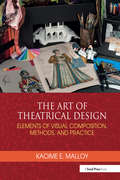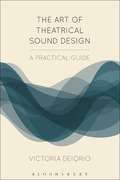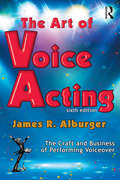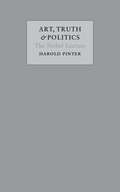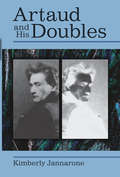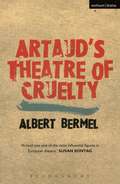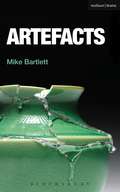- Table View
- List View
The Art of Theatrical Design: Elements of Visual Composition, Methods, and Practice
by Kaoiṁe E. MalloyThe Art of Theatrical Design: Elements of Visual Composition, Methods, and Practice, Second Edition, contains an in-depth discussion of design elements and principles for costume, set, lighting, sound, projection, properties, and makeup designs.This textbook details the skills necessary to create effective, evocative, and engaging theatrical designs that support a play contextually, thematically, and visually. It covers key concepts such as content, context, genre, style, play structure, and format and the demands and limitations of various theatrical spaces. The book also discusses essential principles, including collaboration, inspiration, conceptualization, script analysis, conducting effective research, building a visual library, developing an individual design process, and the role of the critique in collaboration. This second edition includes A new chapter on properties management and design. A new chapter on makeup design. A new chapter on digital rendering, with evaluations of multiple programs, overviews of file types and uses, and basic tutorials in Adobe® Photoshop® and Procreate. An expanded and revised chapter on traditional rendering, with the inclusion of new media, including watercolor, gouache, and mixed media, and updated exercises and tutorials. Revised and expanded chapters on individual design areas, including additional practices for conceptualization and collaboration, with new exercises for skill development. Additional exercises in all elements and principles of design chapters for investigation of each design principle and skill development. Revised and updated content throughout the text, reflecting current pedagogy and practices. This book gives students in theatrical design, introduction to design, and stagecraft courses the grounding in core design principles they need to approach design challenges and make design decisions in both assigned class projects and realized productions.The Art of Theatrical Design provides access to additional online resources, including step-by-step video tutorials of the exercises featured in the book.
The Art of Theatrical Design: Elements of Visual Composition, Methods, and Practice
by Kaoime MalloyThe Art of Theatrical Design: Elements of Visual Composition, Methods, and Practice addresses the core principles that develop the student designer into a true artist, providing a foundation that ensures success with each production design. This text concentrates on the skills necessary to create effective, evocative, and engaging theatrical designs that support the play contextually, thematically, and visually. It gives students the grounding in core design principles they need to approach design challenges and make design decisions in both assigned class projects and realized productions. This book features: In-depth discussions of design elements and principles for costume, set, lighting, sound, and projection designs Coverage of key concepts such as content, context, genre, style, play structure and format, and the demands and limitations of various theatrical spaces Essential principles, including collaboration, inspiration, conceptualization, script analysis, conducting effective research, building a visual library, developing an individual design process, and the role of the critique in collaboration Information on recent digital drawing tool technology, such as the Wacom® Inkling pen, Wacom® Intuos digitizing tablets and digital sketching, and rendering programs such as Autodesk® Sketchbook Pro and Adobe® Photoshop® Chapter exercises and key terms designed to provide an engaging experience with the material and to facilitate student understanding
The Art of Theatrical Design: Elements of Visual Composition, Methods, and Practice
by Kaoime MalloyThe Art of Theatrical Design: Elements of Visual Composition, Methods, and Practice addresses the core principles that develop the student designer into a true artist, providing a foundation that ensures success with each production design. This text concentrates on the skills necessary to create effective, evocative, and engaging theatrical designs that support the play contextually, thematically, and visually. It gives students the grounding in core design principles they need to approach design challenges and make design decisions in both assigned class projects and realized productions. This book features: In-depth discussions of design elements and principles for costume, set, lighting, sound, and projection designs Coverage of key concepts such as content, context, genre, style, play structure and format, and the demands and limitations of various theatrical spaces Essential principles, including collaboration, inspiration, conceptualization, script analysis, conducting effective research, building a visual library, developing an individual design process, and the role of the critique in collaboration Information on recent digital drawing tool technology, such as the Wacom® Inkling pen, Wacom® Intuos digitizing tablets and digital sketching, and rendering programs such as Autodesk® Sketchbook Pro and Adobe® Photoshop® Chapter exercises and key terms designed to provide an engaging experience with the material and to facilitate student understanding
The Art of Theatrical Sound Design: A Practical Guide (Backstage)
by Victoria DeiorioEmphasising the artistry behind the decisions made by theatrical sound designers, this guide is for anyone seeking to understand the nature of sound and how to apply it to the stage. Through tried-and-tested advice and lessons in practical application, The Art of Theatrical Sound Design allows developing artists to apply psychology, physiology, sociology, anthropology and all aspects of sound phenomenology to theatrical sound design. Structured in three parts, the book explores, theoretically, how human beings perceive the vibration of sound; offers exercises to develop support for storytelling by creating an emotional journey for the audience; considers how to collaborate and communicate as a theatre artist; and discusses how to create a cohesive sound design for the stage.
The Art of Theatrical Sound Design: A Practical Guide (Backstage)
by Victoria DeiorioEmphasising the artistry behind the decisions made by theatrical sound designers, this guide is for anyone seeking to understand the nature of sound and how to apply it to the stage. Through tried-and-tested advice and lessons in practical application, The Art of Theatrical Sound Design allows developing artists to apply psychology, physiology, sociology, anthropology and all aspects of sound phenomenology to theatrical sound design. Structured in three parts, the book explores, theoretically, how human beings perceive the vibration of sound; offers exercises to develop support for storytelling by creating an emotional journey for the audience; considers how to collaborate and communicate as a theatre artist; and discusses how to create a cohesive sound design for the stage.
The Art of Translation (Oberon Masters Series)
by Ranjit Bolt‘I try to follow the rule laid down by perhaps the greatest translator of all, John Dryden, who maintained that a translator should – and I paraphrase – make the version as entertaining as possible, while at the same time remaining as faithful as possible to the spirit of the original’ – Ranjit Bolt.In this book, Ranjit Bolt takes what is essentially a practitioner's view of the art of literary translation. His observations are born of a quarter of a century's experience of translating for a living, especially for the theatre. While rooted in practice, however, this survey does not shy away from theory, but is packed with allusion to great translation theorists such as Walter Benjamin and John Dryden, as well as adumbrating Bolt's own theoretical stance.‘There is much practical good sense in this engaging, good-humouredapologia pro domo’ - Times Literary Supplement‘If you’re interested in writing plays you need to read The Art of Translation. Even if you have no intention of translating a play Bolt has a lot to teach about how dramatic language works.’ - The Stage‘Bolt’s essay is provocative and engaging, drawing heavily on twenty years of direct first-hand experience as the writer of some of the most lively modern translations of classical into English… Bolt has a very satisfying turn of phrase, and the book is full of teasingly provocative and wondefully quotable opinions.’ – Journal of Adaptation in Film & Performance
The Art of Unarmed Stage Combat
by Robert NajarianThe Art of Unarmed Stage Combat is your guide to the principles and techniques of theatrical violence, combining detailed discussions of the mechanics of stage fighting with the nuances of acting decisions to make fighting styles reflect character and story. Expert Fight Director Robert Najarian offers never-before-published games and exercises that will allow you to develop the skills and concepts for performing violence for stage and screen. This title utilizes a unique system of training techniques that result in stage violence that is both physically engaging for you as a performer, while remaining viscerally engaging for the audience.
The Art of Unarmed Stage Combat
by Robert NajarianThe Art of Unarmed Stage Combat is your guide to the principles and techniques of theatrical violence, combining detailed discussions of the mechanics of stage fighting with the nuances of acting decisions to make fighting styles reflect character and story. Expert Fight Director Robert Najarian offers never-before-published games and exercises that will allow you to develop the skills and concepts for performing violence for stage and screen. This title utilizes a unique system of training techniques that result in stage violence that is both physically engaging for you as a performer, while remaining viscerally engaging for the audience.
The Art of Voice Acting: The Craft and Business of Performing for Voiceover
by James AlburgerThe Art of Voice Acting covers all aspects of the craft and business of performing voiceover. This sixth edition is reorganized and completely updated to include the latest information on how to get started in voiceover, performing techniques, setting up a personal recording space, voiceover demos, the basics of running a voiceover business, working with agents, unions, and much more. Dozens of URL’s are included with additional resources and several chapters include all new scripts written specifically for this edition. Two new chapters include contributions from some of the voiceover world’s top professionals. Additional content can be found on the Voice Acting Academy website at AOVA.VoiceActing.com. This is the perfect tool for aspiring voice performers, radio announcers, and stage and screen actors.
The Art of Voice Acting: The Craft and Business of Performing for Voiceover
by James AlburgerThe Art of Voice Acting covers all aspects of the craft and business of performing voiceover. This sixth edition is reorganized and completely updated to include the latest information on how to get started in voiceover, performing techniques, setting up a personal recording space, voiceover demos, the basics of running a voiceover business, working with agents, unions, and much more. Dozens of URL’s are included with additional resources and several chapters include all new scripts written specifically for this edition. Two new chapters include contributions from some of the voiceover world’s top professionals. Additional content can be found on the Voice Acting Academy website at AOVA.VoiceActing.com. This is the perfect tool for aspiring voice performers, radio announcers, and stage and screen actors.
The Art of Writing for the Theatre: An Introduction to Script Analysis, Criticism, and Playwriting (Introductions to Theatre)
by Luke YankeeWriting for the theatre and about theatre requires a diverse set of skills, but whether you're studying theatre or developing your creative craft, this book covers everything you need to know. Filled with practical advice from an award-winning playwright, with a range of resources to guide you in the craft and business of theatre writing, The Art of Writing for the Theatre provides everything you need to write like a seasoned theatre professional, including:* how to analyze and break down a script, * how to write various types of plays, from short plays, plays for one person, to one act and full length dramas, * how to critique a play and a theatre production, * how to construct and craft essays, cover letters, theatrical resumes, applications, and * how to avoid common grammar and punctuation errors.This thorough introduction is supplemented with exercises and new interviews with a host of internationally acclaimed playwrights, lyricists, and critics, including Lyn Gardner, Kia Corthron, Ismail Khalidi, Marsha Norman, and David Zippel, among many others. Accompanying online resources include playwriting and script analysis worksheets and exercises, an example of a playwriting resume, and critical points to consider on playwriting, design, acting, directing and choreography.
The Art of Writing for the Theatre: An Introduction to Script Analysis, Criticism, and Playwriting (Introductions to Theatre)
by Luke YankeeWriting for the theatre and about theatre requires a diverse set of skills, but whether you're studying theatre or developing your creative craft, this book covers everything you need to know. Filled with practical advice from an award-winning playwright, with a range of resources to guide you in the craft and business of theatre writing, The Art of Writing for the Theatre provides everything you need to write like a seasoned theatre professional, including:* how to analyze and break down a script, * how to write various types of plays, from short plays, plays for one person, to one act and full length dramas, * how to critique a play and a theatre production, * how to construct and craft essays, cover letters, theatrical resumes, applications, and * how to avoid common grammar and punctuation errors.This thorough introduction is supplemented with exercises and new interviews with a host of internationally acclaimed playwrights, lyricists, and critics, including Lyn Gardner, Kia Corthron, Ismail Khalidi, Marsha Norman, and David Zippel, among many others. Accompanying online resources include playwriting and script analysis worksheets and exercises, an example of a playwriting resume, and critical points to consider on playwriting, design, acting, directing and choreography.
Art & Science of Music Therapy: A Handbook
by Tony Wigram Bruce Saperston Robert WestFirst Published in 1995. Routledge is an imprint of Taylor & Francis, an informa company.
Art & Science of Music Therapy: A Handbook
by Tony Wigram Bruce Saperston Robert WestFirst Published in 1995. Routledge is an imprint of Taylor & Francis, an informa company.
Art, Truth and Politics: The Nobel Lecture
by Harold PinterArts, Truth and Politics is Harold Pinter's lecture on receipt of the 2005 Nobel Prize in Literature.
Art, Vision, and Nineteenth-Century Realist Drama: Acts of Seeing (Routledge Advances in Theatre & Performance Studies)
by Amy HolzapfelRealism in theatre is traditionally defined as a mere seed of modernism, a crude attempt to reproduce an exact copy of reality on stage. Art, Vision & Nineteenth-Century Realist Drama redefines realism as a complex and under-examined form of visual modernism, one that positioned theatre at the crux of the encounter between consciousness and the visible world. Tracing a historical continuum of "acts of seeing" on the realist stage, Holzapfel demonstrates how theatre participated in modernity’s aggressive interrogation of vision’s residence in the human body. New findings by scientists and philosophers—such as Diderot, Goethe, Müller, Helmholtz, and Galton—exposed how the visible world is experienced and framed by the unstable relativism of the physiological body rather than the fixed idealism of the mind. Realist artists across media paradoxically embraced this paradigm shift by focusing on the embodied observer. Drawing from extensive archival research, Holzapfel conducts close readings of iconic dramas and their productions—including Scribe’s The Glass of Water, Zola’s Thérèse Raquin, Ibsen’s A Doll House, Strindberg’s The Father, and Hauptmann’s Before Sunrise—alongside analyses of artwork by major painters and photographers—such as Chardin, Nadar, Millais, Rejlander, and Liebermann. In a radical challenge to existing criticism, Holzapfel argues that realism in theatre was never the attempt to reproduce an exact copy of the seen world but rather the struggle to make visible the act of seeing.
Art, Vision, and Nineteenth-Century Realist Drama: Acts of Seeing (Routledge Advances in Theatre & Performance Studies)
by Amy HolzapfelRealism in theatre is traditionally defined as a mere seed of modernism, a crude attempt to reproduce an exact copy of reality on stage. Art, Vision & Nineteenth-Century Realist Drama redefines realism as a complex and under-examined form of visual modernism, one that positioned theatre at the crux of the encounter between consciousness and the visible world. Tracing a historical continuum of "acts of seeing" on the realist stage, Holzapfel demonstrates how theatre participated in modernity’s aggressive interrogation of vision’s residence in the human body. New findings by scientists and philosophers—such as Diderot, Goethe, Müller, Helmholtz, and Galton—exposed how the visible world is experienced and framed by the unstable relativism of the physiological body rather than the fixed idealism of the mind. Realist artists across media paradoxically embraced this paradigm shift by focusing on the embodied observer. Drawing from extensive archival research, Holzapfel conducts close readings of iconic dramas and their productions—including Scribe’s The Glass of Water, Zola’s Thérèse Raquin, Ibsen’s A Doll House, Strindberg’s The Father, and Hauptmann’s Before Sunrise—alongside analyses of artwork by major painters and photographers—such as Chardin, Nadar, Millais, Rejlander, and Liebermann. In a radical challenge to existing criticism, Holzapfel argues that realism in theatre was never the attempt to reproduce an exact copy of the seen world but rather the struggle to make visible the act of seeing.
Artaud and His Doubles: Theory/text/performance: Artaud And His Doubles (Theater: Theory/Text/Performance)
by Kimberly JannaroneArtaud and His Doublesis a radical re-thinking of one of the most influential theater figures of the twentieth century. Placing Artaud's writing within the specific context of European political, theatrical, and intellectual history, the book reveals Artaud's affinities with a disturbing array of anti-intellectual and reactionary writers and artists whose ranks swelled catastrophically between the wars in Western Europe. Kimberly Jannarone shows that Artaud's work reveals two sets of doubles: one, a body of peculiarly persistent received interpretations from the American experimental theater and French post-structuralist readings of the 1960s; and, two, a darker set of doubles---those of Artaud's contemporaries who, in the tumultuous, alienated, and pessimistic atmosphere enveloping much of Europe after World War I, denounced the degradation of civilization, yearned for cosmic purification, and called for an ecstatic loss of the self. Artaud and His Doubles will generate provocative new discussions about Artaud and fundamentally challenge the way we look at his work and ideas.
Artaud's Theatre Of Cruelty (Plays and Playwrights)
by Albert BermelThe definitive guide to the life and work of Antonin ArtaudAntonin Artaud's theatre of cruelty is one of the most vital forces in world theatre, yet the concept is one of the most frequently misunderstood. In this incisive study, Albert Bermel looks closely at Artaud's work as a playwright, director, actor, designer, producer and critic, and provides a fresh insight into his ideas, innovations and, above all, his writings.Tracing the theatre of cruelty's origins in earlier dramatic conventions, tribal rituals of cleansing, transfiguration and exaltation, and in related arts such as film and dance, Bermel examines each of Artaud's six plays for form and meaning, as well as surveying the application of Artaud's theories and techniques to the international theatre of recent years.
Artaud's Theatre Of Cruelty (Plays and Playwrights)
by Albert BermelThe definitive guide to the life and work of Antonin ArtaudAntonin Artaud's theatre of cruelty is one of the most vital forces in world theatre, yet the concept is one of the most frequently misunderstood. In this incisive study, Albert Bermel looks closely at Artaud's work as a playwright, director, actor, designer, producer and critic, and provides a fresh insight into his ideas, innovations and, above all, his writings.Tracing the theatre of cruelty's origins in earlier dramatic conventions, tribal rituals of cleansing, transfiguration and exaltation, and in related arts such as film and dance, Bermel examines each of Artaud's six plays for form and meaning, as well as surveying the application of Artaud's theories and techniques to the international theatre of recent years.
Artefacts (Modern Plays)
by Mike BartlettSixteen-year-old Kelly has never known her Dad. Turns out he's from Iraq, which her mum never mentioned, and he's brought an ancient Mesopotamian vase as some kind of present. But Kelly doesn't want a vase. She wants her dad to stay and get to know her. It's not the reunion either of them expected and for Kelly, it's the beginning of an epic and dangerous journey.Mike Bartlett has been described as 'One of the most exciting new talents to emerge in recent times'. (The Stage). His first play My Child was called 'Brutal, thrilling, unmissable' (Evening Standard) and 'the theatrical equivalent of a firecracker'. (Metro).
Artefacts: My Child, Contractions, Artefacts, Cock, Not Talking (Modern Plays)
by Mike BartlettSixteen-year-old Kelly has never known her Dad. Turns out he's from Iraq, which her mum never mentioned, and he's brought an ancient Mesopotamian vase as some kind of present. But Kelly doesn't want a vase. She wants her dad to stay and get to know her. It's not the reunion either of them expected and for Kelly, it's the beginning of an epic and dangerous journey.Mike Bartlett has been described as 'One of the most exciting new talents to emerge in recent times'. (The Stage). His first play My Child was called 'Brutal, thrilling, unmissable' (Evening Standard) and 'the theatrical equivalent of a firecracker'. (Metro).
Arthur Lessac's Embodied Actor Training
by Melissa HurtArthur Lessac’s Embodied Actor Training situates the work of renowned voice and movement trainer Arthur Lessac in the context of contemporary actor training. Supported by the work of Constantin Stanislavsky and Maurice Merleau-Ponty's theories of embodiment, the book explores Lessac's practice in terms of embodied acting, a key subject in contemporary performance. In doing so, the author explains how the actor can come to experience both skill and expression as a subjective whole through active meditation and spatial attunement. As well as feeding this psychophysical approach into a wider discussion of embodiment, the book provides concrete examples of how the practice can be put into effect. Using insights gleaned from interviews conducted with Lessac and his Master Teachers, the author enlightens our own understanding of Lessac’s practices. Three valuable appendices enhance the reader’s experience. These include: a biographical timeline of Lessac’s life and career sample curricula and a lesson plan for teachers at university level explorations for personal discovery Melissa Hurt is a Lessac Certified Trainer and has taught acting and Lessac’s voice, speech, and movement work at colleges across the United States. She has a PhD from the University of Oregon and an MFA from Virginia Commonwealth University.
Arthur Lessac's Embodied Actor Training
by Melissa HurtArthur Lessac’s Embodied Actor Training situates the work of renowned voice and movement trainer Arthur Lessac in the context of contemporary actor training. Supported by the work of Constantin Stanislavsky and Maurice Merleau-Ponty's theories of embodiment, the book explores Lessac's practice in terms of embodied acting, a key subject in contemporary performance. In doing so, the author explains how the actor can come to experience both skill and expression as a subjective whole through active meditation and spatial attunement. As well as feeding this psychophysical approach into a wider discussion of embodiment, the book provides concrete examples of how the practice can be put into effect. Using insights gleaned from interviews conducted with Lessac and his Master Teachers, the author enlightens our own understanding of Lessac’s practices. Three valuable appendices enhance the reader’s experience. These include: a biographical timeline of Lessac’s life and career sample curricula and a lesson plan for teachers at university level explorations for personal discovery Melissa Hurt is a Lessac Certified Trainer and has taught acting and Lessac’s voice, speech, and movement work at colleges across the United States. She has a PhD from the University of Oregon and an MFA from Virginia Commonwealth University.
Arthur Miller: A Critical Study
by Christopher BigsbyAuthorised biography of one of the greatest of modern playwrights, Arthur Miller (1915-2005). This is the long-awaited authorised biography of one of the twentieth century's (and America's) greatest playwrights, whose accomplishment bears comparison with Eugene O'Neill and Tennessee Williams. A post-war decade of work earned him international critical and popular acclaim - 'All My Sons' (1947), 'Death of a Salesman' (1949), 'The Crucible' (1953) and 'A View from the Bridge' (1955) are modern classics of the theatre. Miller was born in 1915 and wrote during a fascinating time in American history. He matured during the Great Depression and like many found hope for the beleaguered common man in Communism in a country that was essentially deeply conservative. The Great Depression was a period of deprivation for many that left a mark upon the national psyche comparable to the mark the family feud of the American Civil War left upon the nation. The chill left by the shadow of sudden collapse of banks and businesses and farms was felt for many years after the US had become prosperous. The Second World War elevated the common man to war hero and it was not until Japan was defeated and the Cold War began that the ugly elements of American conservatism would freely persecute writers and artists who had embraced Communism, no matter if it had only been flirtatiously. Miller was among them. His refusal to name names and to co-operate with the notorious House of Un-American Activities gave him a heroic role to play. In that same year, 1956, Arthur Miller momentously got married a second time - to Marilyn Monroe. The biography ends shortly after her tragic death in 1962, and eloquently shows how their relationship informed Miller's great plays.

